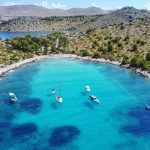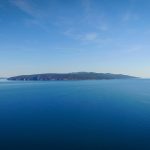An incredible discovery is made in the Zadar region.
The Zadar region is known for having provided an abundance of historical finds over the years, and the nearby Pašman channel is continuing to slowly reveal what hides beneath the surface of the sparkling Adriatic to archaeologists, and the seabed between the islet of Ričul and the nearby Turanj coastline is offering a plethora of various archeological gems dating back to as long ago as the Bronze Age.
As Morski writes on the 20th of October, 2018, the prehistoric period is a time in the very, very distant past in which little is really known about Northern Dalmatia to this very day, and it was only a few years ago that archaeologists really began their underwater explorations around the islet of Ričul, according to a report from Radio Zadar. Well-preserved organic material, hidden under overgrown, thick marine cultures, allows such discoveries to be deeply analysed and offers data which is rarely available on land-based sites. In this way, these finds enrich our overall understanding of the lives of ancient communities who lived in this area until about three millennia ago.
The staff of the Department of Archeology at the University of Zadar have been carrying out systematic underwater research, thanks to the financial support of the Ministry of Culture of the Republic of Croatia, the Municipality of Sveti Filip i Jakov, and the logistical support of Alan Mandić from Turanj. Currently underway is the fifth underwater archaeological campaign, which began back in mid-September this year.
Involved in this process are doc. dr. sc. Mato Ilkić (Research Manager), doc. dr. sc. Mate Parica (Deputy Research Manager), prof. dr. sc. Dario Vujević and student of archeology, Vinko Milišić. In addition to this archaeological team, also participating in this research phase are dr. sc. Martina Čelhar and the Department of Archeology’s Filipa Jurković Pešić. With the help of Petra Govorčin, Aleksandra Matura, Filipa Vukres and Antonela Klobučar, they undertook probation excavations around the islet of Ričul, with the aim of determining the possible cultural connection of the land part of the islet with what lies underwater.
During those investigations, the archaeological team discovered numerous fragments of prehistoric ceramics and a piece of tiled stone, likely the remains of some type of old fence.
The diving team directed their explorations to the seabed, where the archeological remains of a thicker wall lie, revealed Dr. Ilkić.
”Its outer and inner face is made from amorphous stone, and within that construction there’s also quite a lot of wood. It’s very likely that these are the remains of the protective rampart, which protected the Bronze Age settlement from possible dangers from the land side,” stated Ilkić.
They also discovered pieces of prehistoric ceramic and a tool made from polished stone. But that’s not all. Numerous olive pits were discovered, and they’re deemed to be around 3,500 years old.
At the very beginning of this research a few years ago, one such olive pit was found underwater near Ričul, but it wasn’t sufficient for analysis. Namely, at least forty such examples are required for proper analysis, and hundreds of them have now finally been found. The pits will be sent to an expert, prof. dr. sc. Đani Benčić from the Zagreb School of Agronomy, in order to conduct scans and see if these pits belong to the family of any olives that may still exist in Northern Dalmatia today. In addition to the olive pits, what are believed to be ancient cherry pits have also been discovered in the same area.
It could be assumed from such findings that the members of the ancient communities which once lived in these areas were properly and diversely fed. They certainly didn’t lack meat, as has already been indicated by the discovery of numerous ancient bones from various livestock animals, including those belonging to cattle, goats, and sheep. Other findings would suggest that these people also had access to bread, according to Dr. Parica. The fact this ancient community settled right by the sea suggests that part of their diet was also fish.
That same sea has allowed staff members of the Department of Archeology from the University of Zadar to discover bio-archeological traces which speak of the oldest organised olive growers in the Croatian part of the Adriatic sea.
Click here for the original report by Radio Zadar








